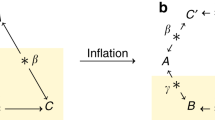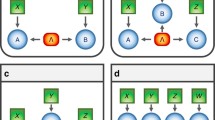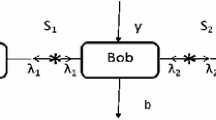Abstract
Recently Bell-type inequalities were introduced in Branciard et al. (Phys Rev A 85:032119, 2012) to analyze the correlations emerging in an entanglement swapping scenario characterized by independence of the two sources shared between three parties. The corresponding scenario was referred to as bilocal scenario. Here, we derive Bell-type inequalities in \(n+1\) party scenario, i.e., in \(n\)-local scenario. Considering the two different cases with several number of inputs and outputs, we derive local and \(n\)-local bounds. The \(n\)-local inequality studied for two cases are proved to be tight. Replacing the sources by maximally entangled states for two binary inputs and two binary outputs and also for the fixed input and four outputs, we observe quantum violations of \(n\)-local bounds. But the resistance offered to noise cannot be increased as compared to the bilocal scenario. Thus increasing the number of parties in a linear fashion in source-independent scenario does not contribute in lowering down the requirements of revealing quantumness in a network in contrast to the star configuration (Tavakoli et al. in Phys Rev A 90:062109, 2014) of \(n+1\) parties.




Similar content being viewed by others
References
Acin, A., Brunner, N., Gisin, N., Massar, S., Pironio, S., Scarani, V.: Device-independent security of quantum cryptography against collective attacks. Phys. Rev. Lett. 98, 230501 (2007)
Mayers, D., Yao, A.: Unconditional security in quantum cryptography, In: Proceedings of the 39th IEEE Symposium on Foundations of Computer Science IEEE Computer Society, p. 503. Los Alamitos (1998)
Pironio, S., Acin, A., Massar, S., de la Giroday, A.B., Matsukevich, D.N., Maunz, P., Olmschenk, S., Hayes, D., Luo, L., Manning, T.A., Monroe, C.: More randomness from noisy sources. Nature 464, 1021 (2010)
Colbeck, R., Kent, A.: Private randomness expansion with untrusted devices. J. Phys. A Math. Theor. 44, 095305 (2011)
Bancal, J.-D., Gisin, N., Liang, Y.-C., Pironio, S.: Device-independent witnesses of genuine multipartite entanglement. Phys. Rev. Lett. 106, 250404 (2011)
Cleve, R., Buhrman, H.: Substituting quantum entanglement for communication. Phys. Rev. A 56, 1201 (1997)
Acin, A., et al.: Device-independent security of quantum cryptography against collective attacks. Phys. Rev. Lett. 98, 230501 (2007)
Briegel, H.-J., et al.: Quantum repeaters: the role of imperfect local operations in quantum communication. Phys. Rev. Lett. 81, 5932 (1998)
Raussendorf, R., Briegel, H.J.: A one-way quantum computer. Phys. Rev. Lett. 86, 5188 (2001)
Bell, J.: Speakable and Unspeakable in Quantum Mechanics, 2nd edn. Cambridge University Press, Cambridge (2004)
Bell, J.S.: On the Einstein Podolsky Rosen paradox. Physics 1, 195 (1964)
Hammerer, K., Sørensen, A.S., Polzik, E.S.: Quantum interface between light and atomic ensembles. Rev. Mod. Phys. 82, 1041 (2010)
Zukowski, M., et al.: Event-ready-detectors Bell experiment via entanglement swapping. Phys. Rev. Lett. 71, 4287 (1993)
Branciard, C., Gisin, N., Pironio, S.: Characterizing the nonlocal correlations created via entanglement swapping. Phys. Rev. Lett. 104, 170401 (2010)
Fritz, T.: Beyond Bell’s theorem: correlation scenarios. New J. Phys. 14, 103001 (2012)
Fritz, T.: Beyond Bell’s theorem II: scenarios with arbitrary causal structure, arXiv:1404.4812 (2014)
Henson, J., Lal, R., Pusey, M.F.: Theory-independent limits on correlations from generalized Bayesian networks. New J. Phys. 16, 113043 (2014)
Tavakoli, A., Skrzypczyk, P., Cavalcanti, D., Acin, A.: Nonlocal correlations in the star-network configuration. Phys. Rev. A 90, 062109 (2014)
Branciard, C., Rosset, D., Gisin, N., Pironio, S.: Bilocal versus non-bilocal correlations in entanglement swapping experiments. Phys. Rev. A 85, 032119 (2012)
Gisin, N., Gisin, B.: A local variable model for entanglement swapping exploiting the detection loophole. Phys. Lett. A 297, 279 (2002)
Greenberger, D.M., Horne, M., Zeilinger, A.: Bell theorem without inequalities for two particles. II. Inefficient detectors. Phys. Rev. A 78, 022111 (2008)
Clauser, J.F., Horne, M.A., Shimony, A., Holt, R.A.: Proposed experiment to test local hidden-variable theories. Phys. Rev. Lett. 23, 880 (1969)
Vertesi, T., Pironio, S., Brunner, N.: Closing the detection loophole in Bell experiments using qudits. Phys. Rev. Lett. 104, 060401 (2010)
Helstrom, C.W.: Quantum Detection and Estimation Theory. Academic Press, New York (1976)
Nielsen, M.A., Chuang, I.L.: Quantum Computation and Quantum Information. Cambridge University Press, Cambridge (2000)
Acknowledgments
The authors are grateful to D. Rosset and C. Branciard for stimulating discussions on the topic while visiting Kolkata. The authors also thank Ajoy Sen for interesting and helpful discussions relating to the topic of this work. The author KM acknowledges the financial support by UGC, New Delhi.
Author information
Authors and Affiliations
Corresponding author
Appendices
Appendix 1: representation of the \(4\)-local correlation in terms of \(q_{\bar{\alpha }_{1}\bar{ \alpha }_{2} \bar{\alpha }_{3}\bar{\alpha }_{4}}\)
We note here that \(\bar{\alpha }_{1}\) is specified by \(\lambda _1\); \( \bar{ \alpha }_{2}\) is specified by \(\lambda _1, \lambda _2\); \( \bar{\alpha }_{3}\) is specified by \(\lambda _2, \lambda _3\); and \( \bar{\alpha }_{4}\) is specified by \(\lambda _3\). Then \(\bigcup _{\bar{ \alpha }_{2}}\Lambda ^{123}_{\bar{\alpha }_{1}\bar{ \alpha }_{2} \bar{\alpha }_{3}\bar{\alpha }_{4}} = \Lambda ^{123}_{\bar{\alpha }_{1}\bar{\alpha }_{3}\bar{\alpha }_{4}} = \Lambda ^{1}_{\bar{\alpha }_{1}} \times {\Lambda ^{23}_{\bar{\alpha }_{3}\bar{\alpha }_{4}}}\), \(\bigcup _{\bar{\alpha }_{3}}\Lambda ^{123}_{\bar{\alpha }_{1}\bar{ \alpha }_{2} \bar{\alpha }_{3}\bar{\alpha }_{4}} = \Lambda ^{123}_{\bar{\alpha }_{1}\bar{\alpha }_{2}\bar{\alpha }_{4}} = \Lambda ^{12}_{\bar{\alpha }_{1}\bar{\alpha }_{2}} \times {\Lambda ^{3}_{\bar{\alpha }_{4}}}\) and
where \(\Lambda ^1 = \bigcup _{\bar{\alpha }_{1}}\Lambda ^{1}_{\bar{\alpha }_{1}}\) , \(\Lambda ^2 =\bigcup _{\bar{\alpha }_{2}\bar{\alpha }_{3}}\Lambda ^{2}_{\bar{\alpha }_{2}\bar{\alpha }_{3}}\) and \(\Lambda ^3 = \bigcup _{\bar{\alpha }_{4}}\Lambda ^{3}_{\bar{\alpha }_{4}}\) are the corresponding state spaces of the variables \(\lambda _1, \lambda _2\) and \(\lambda _3\), respectively.
Now if we now consider \(P\) as \(4\)-local, then the independence condition (7) implies [Eq. (42) is obtained from (35), (39), (40) and Eq. (43) is obtained from (36), (38), (41)] for all \(\bar{\alpha }_{1}, \bar{\alpha }_{3}\) and \(\bar{\alpha }_{4}\),
The above result can be easily extended to \(n\)-local scenario.
Appendix 2: Proof of Eq. (16)
We define,
Since by assumption \(P^{22}\) is \(n\)-local, it has a \(n\)-local decomposition of the form (6) and (7). So we get,
Now,
Using the above relation, we have,
Similarly for \(J^{22}_{A_2,\ldots A_n}\) it can be shown that,
Now, by using Holder’s inequality for \(4\) positive quantities \(\mid (\langle A_{1,0}+A_{1,1}\rangle )_{\lambda _{1}}\mid \), \(\mid (\langle A_{1,0}-A_{1,1}\rangle )_{\lambda _{1}}\mid \), \(\mid (\langle A_{n+1,0}+A_{n+1,1}\rangle )_{\lambda _{n}}\mid \), \(\mid (\langle A_{n+1,0}-A_{n+1,1}\rangle )_{\lambda _{n}}\mid \) we get,
Again, \(\frac{\mid (\langle A_{1,0}+A_{1,1}\rangle )_{\lambda _{1}}\mid }{2}+\frac{\mid (\langle A_{1,0}-A_{1,1}\rangle )_{\lambda _{1}}\mid }{2}\) = \(\max (\mid \langle A_{1,0}\rangle _{\lambda _{1}}\mid , \mid \langle A_{1,1}\rangle _{\lambda _{1}}\mid )\le 1\) and similarly \(\max (\mid \langle A_{n+1,0}\rangle _{\lambda _{1}}\mid , \mid \langle A_{n+1,1}\rangle _{\lambda _{1}}\mid )\le 1\). Using these we get,
Hence the inequality (16) is satisfied. \(\square \)
Rights and permissions
About this article
Cite this article
Mukherjee, K., Paul, B. & Sarkar, D. Correlations in \(n\)-local scenario. Quantum Inf Process 14, 2025–2042 (2015). https://doi.org/10.1007/s11128-015-0971-7
Received:
Accepted:
Published:
Issue Date:
DOI: https://doi.org/10.1007/s11128-015-0971-7




